Plasma osmolality - Study guides, Revision notes & Summaries
Looking for the best study guides, study notes and summaries about Plasma osmolality? On this page you'll find 1834 study documents about Plasma osmolality.
Page 3 out of 1.834 results
Sort by
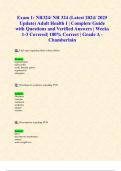
-
Exam 1: NR324/ NR 324 (Latest 2024/ 2025 Update) Adult Health I | Complete Guide with Questions and Verified Answers | Weeks 1-3 Covered| 100% Correct | Grade A - Chamberlain
- Exam (elaborations) • 48 pages • 2024
- Available in package deal
-
- £9.44
- + learn more
Exam 1: NR324/ NR 324 (Latest 2024/ 2025 Update) Adult Health I | Complete Guide with Questions and Verified Answers | Weeks 1-3 Covered| 100% Correct | Grade A - Chamberlain Q: Vital signs regarding fluid volume deficit Answer: hyperthermia tachycardia weak, thready pulses hypotension tachypnea Q: Neurological symptoms regarding FVD Answer: Dizziness syncope confusion weakness fatigue seizures Q: GI symptoms regarding FVD Answer: thirst dry mucous me...
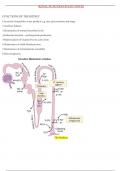
-
RENAL FUNCTION STUDY NOTES
- Summary • 34 pages • 2024
- Available in package deal
-
- £14.79
- + learn more
FUNCTIONS OF THE KIDNEY 1.Excretion of metabolic waste products e.g. urea and creatinine and drugs 2.Acid:base balance 3.Maintenance of normal electrolyte levels 4.Endocrine function – erythropoietin production 5.Hydroxylation of Vitamin D to its active form 6.Maintenance of stable blood pressure 7.Maintenance of normal plasma osmolality 8.Gluconeogenesis
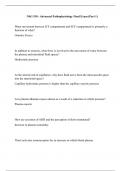
-
NSG 530 - Advanced Pathophysiology Final Exam (Part 1)
- Exam (elaborations) • 26 pages • 2024
-
- £6.58
- + learn more
Water movement between ICF compartment and ECF compartment is primarily a function of what? Osmotic Forces In addition to osmosis, what force is involved in the movement of water between the plasma and interstitial fluid spaces? Hydrostatic pressure At the arterial end of capillaries, why does fluid move from the intravascular space into the interstitial space? Capillary hydrostatic pressure is higher than the capillary oncotic pressure Low plasma albumin causes edema as a resu...
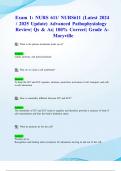
-
Exam 1: NURS 611/ NURS611 (Latest 2024/ 2025 Update) Advanced Pathophysiology Review| Qs & As| 100% Correct| Grade A- Maryville
- Exam (elaborations) • 43 pages • 2024
- Available in package deal
-
- £9.03
- + learn more
Exam 1: NURS 611/ NURS611 (Latest 2024/ 2025 Update) Advanced Pathophysiology Review| Qs & As| 100% Correct| Grade A- Maryville Q: What is the plasma membrane made up of? Answer: Lipids, proteins, and polysaccharides Q: Why do we need a cell membrane? Answer: To keep the ICF and ECF separate, structure, protection, activation of cell, transport, and cell-to-cell interaction Q: How is osmolality different between ICF and ECF? Answer: The osmolality of ICF and EC...
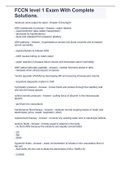
-
FCCN level 1 Exam With Complete Solutions.
- Exam (elaborations) • 13 pages • 2022
-
- £11.50
- 6x sold
- + learn more
minimum urine output for adult 0.5mL/kg/hr ADH (antidiuretic hormone) - water retainer - vasoconstrictor (also called Vasopressin) - produced by hypothalamus - store and released from posterior pituitary ADH pathway - hypothalamus senses low blood volumed and increased serum osmolality - signal pituitary to release ADH - ADH causes kidney to retain water - water retention increases blood volume and decreases serum osmolality ANP (atrial natriuretic peptide) -...
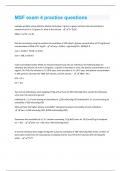
-
MSF exam 4 practice Questions & Answers Solved 100% Correct!!
- Exam (elaborations) • 24 pages • 2024
- Available in package deal
-
- £6.57
- + learn more
example problem using indicator dilution technique, 5 grams is given and then the concentration is measured and it is 1.0 grams %, what is the volume - V= Q/[x] 500ml = 5/1% = 5/.01 find the osmolarity using the sodium concentration of 140 mEq/L, glucose concentration of 70 mg/dl and concentration of BUN of 12 mg/dl - osm = 2[Na+] + [glucose]/18 + [BUN]/2.8 osm = 2(140) + 70/18 + 4.3/2.8 osm = 288.2 mOsm/l inulin and tritiated water (THO) are infused intravenously into an individual. the ...
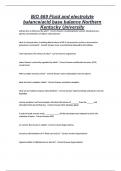
-
BIO 669 Fluid and electrolyte balance/acid base balance Northern Kentucky University
- Exam (elaborations) • 12 pages • 2024
-
- £7.39
- + learn more
BIO 669 Fluid and electrolyte balance/acid base balance Northern Kentucky University aldosterone is influenced by what? - Correct Answer circulating blood volume, blood pressure, plasma concentrations of sodium and potassium what is released when circulating blood volume of BP is decreased or sodium is decreased or potassium is increased? - Correct Answer renin is secreted and released by the kidneys renin stimulates the release of what? - Correct Answer angiotensin water balance is pr...
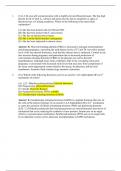
-
PHYS 506 Anatomy and Physiology Endocrine Mini MCQs 70 Answers 2023/24
- Exam (elaborations) • 24 pages • 2023
- Available in package deal
-
- £17.25
- + learn more
PHYS 506 Anatomy and Physiology Endocrine Mini MCQs 70 Answers 2023/24 (14.) A 24-year-old woman presents with a slightly elevated blood pressure. She has high plasma levels of total T4, cortisol, and renin activity, but no symptoms or signs of thyrotoxicosis or Cushing syndrome. Which of the following is the most likely explanation? (A) She has been treated with ACTH and TSH. (B) She has been treated with T3 and cortisol. (C) She has an adrenocortical tumor. (D) She is in the third trim...
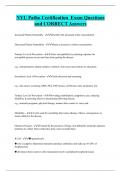
-
NYU Patho Certification Exam Questions and CORRECT Answers
- Exam (elaborations) • 20 pages • 2024
- Available in package deal
-
- £7.39
- + learn more
Increased Plasma Osmolality - Describes the increased solute concentration Decreased Plasma Osmolality - Means a decrease in solute concentration. Primary Level of Prevention - Alters susceptibility by reducing exposure for susceptible persons to prevent them from getting the disease. e.g., immunizations, dental sealants, condoms, skin cancer prevention via education. Secondary Level of Prevention - early detection and screening. e.g., skin cancer screening, DRE, PSA, PAP smears, self bre...
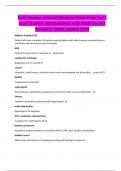
-
Rosh Review: Internal Medicine Exam Prep Test ( Exam Guide)| 554 Questions with 100% Correct Answers| Latest Update 2024
- Exam (elaborations) • 24 pages • 2024
- Available in package deal
-
- £11.09
- + learn more
diabetes insipidus (DI) Patient will have complaints of polyuria and polydipsia with labs showing increased plasma osmolality with decreased urine osmolality ADH Central DI results from a decrease in _ production vasopressin challenge Diagnostic test for central DI central Idiopathic, head trauma, pituitary tumors and neurosurgeries are all possible _ causes of DI DDAVP Treatment for central DI

How much did you already spend on Stuvia? Imagine there are plenty more of you out there paying for study notes, but this time YOU are the seller. Ka-ching! Discover all about earning on Stuvia


